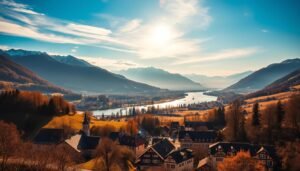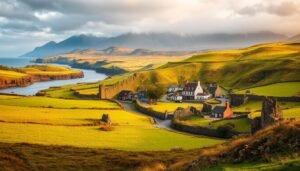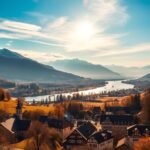Surprising fact: more than 20 million visitors passed through this gateway city in recent years, yet its hilltop miradouros still feel intimate.
I write from the point of view of a traveler who returned often and learned fast. I share a clear guide that balances big squares, tiled facades, and riverside calm. The 1755 earthquake reshaped downtown into a smart grid around Praça do Comércio and the Rua Augusta Arch, which I walked beneath every morning.
I recommend starting with a 24-hour transport pass to save money and ride funiculars and the Santa Justa Lift. I will point out how to beat lines at Tram 28 and where São Pedro de Alcântara and Santa Luzia offer the best postcard views.
Expect food notes too: warm pastéis de nata, bacalhau, and a quick ginjinha stop. This short plan fits a first-time trip and room for wandering, ferry hops, and calm coastal escapes.
Key Takeaways
- The downtown grid and Praça do Comércio trace back to the 1755 earthquake redesign.
- Buy a short transport pass for funiculars and the Santa Justa Lift to save time and cash.
- Seek miradouros like São Pedro de Alcântara for the best skyline views.
- Sample pastéis de nata and ginjinha between landmark stops.
- Plan quick day trips from central stations for Sintra, Cascais, or Cabo da Roca.
Why I Fell for Lisbon: How I Plan My Time in the City

I fell for Lisbon when I learned to let the hills set my agenda and the lifts save my legs. Walking is the best way to feel the city, but a short public transport pass changes the game on steep routes.
My routine starts with a base in central neighborhoods like Chiado, Baixa, Bairro Alto, or Alfama. These hotels offer quick tram and metro links, so I reach waterfront sights and miradouros without wasting time.
I rely on a 24-hour pass when I stack museums and funicular rides. It includes the Santa Justa Lift and cuts cost and lines, so I spend energy on exploring, not queues.
I plan days by neighborhood to avoid backtracking and slot café breaks at viewpoints for slow pauses between places. For key attractions such as Jerónimos Monastery and Belém Tower, I aim for early or late visits and book timed tickets when crowds matter.
- I build a three-day skeleton: Baixa/Chiado/Alfama, Belém and MAAT, then Parque das Nações or a short day trip.
- Spring and early fall are my favorite travel windows for mild weather and fewer lines.
- I always leave one evening free for Fado and a flexible dinner plan.
Praça do Comércio and Baixa: Lisbon’s Rebuilt Heart

I begin my Baixa stroll at Praça do Comércio, where the harbor fronts a wide, open square that marks the city’s dramatic recovery after 1755.
The grid here was laid out with Pombaline building design, made to flex during tremors. You can read that history in the straight avenues and the uniform façades. I use the square as my compass before slipping into cross‑streets.best-time-to-visit-italy
Rua Augusta Arch views and the story of the 1755 earthquake
I climb or ride up the Rua Augusta Arch for a sweeping angle over the patterned pavement. I often spend 20-30 minutes here, lining up the Arch with trams and the river for photos.
Martinho da Arcada and people‑watching on the waterfront
Martinho da Arcada has sat under the arcades since 1782. I grab a table, sip coffee, and watch street life drift past. Nearby, trams to Belém and ferries sit ready, and the Santa Justa Lift or Rossio make easy diversions.
- I look up for yellow façades and iron balconies that glow in morning light.
- Baixa’s straight streets replaced a medieval maze for safety and flow.
- The square is a practical landmark when lanes start to confuse me.
Belém Highlights: Tower, Monastery, and a Riverside Walk
![]()
I time my Belém visits around late afternoon light to catch the Tagus at its most golden. That hour makes the Tower and Monument of the Discoveries glow and eases the crowds for a calmer visit.
Belém Tower and the Monument at sunset
The Tower once guarded the harbor and later served as a prison. I pair it with the Monument along the riverside promenade for a sweeping photo loop.best-time-to-visit-australia/
Jerónimos Monastery cloisters and Vasco da Gama’s tomb
Jerónimos is a UNESCO gem. Its Manueline carvings swirl with ropes and ships; I focus on the cloisters and Vasco da Gama’s tomb. Lines run long, so I buy a timed ticket ahead and leave time for inner gardens.
Pastéis de Belém fresh from the oven
For a sweet break, I head to Pastéis de Belém. A sit-down table often beats the takeaway queue and the original custard pastry tastes best warm.
- I walk a simple loop: Tower → Monument → Monastery → bakery for steady riverside views.
- Photo tip: get low for reflections by the Monument and frame the Tower against the river wall for depth.
- Bring a light layer; evening breezes cool fast after sunset.
Things to Do in Lisbon Portugal: My Essential List
![]()
I like to climb early to the castle for empty ramparts and wide, waking views.
Castelo de São Jorge and Alfama vistas
Castelo de São Jorge crowns the old center with thick walls and sweeping panoramas. I arrive at opening to avoid lines and heat; skip-the-line tickets help on busy days.
Stroll the ramparts in sturdy shoes and pause at lookout points that frame the river, the bridge, and Baixa below.
MAAT’s wavy rooftop for golden hour
MAAT’s curved roof opened in 2016 and offers a free riverfront walk. I time my visit for golden hour so silhouettes and reflections pop over the Tagus and the 25 de Abril Bridge.
Time Out Market vs more local mercados
Time Out Market is buzzy with many stalls and popular choices, but it can be crowded and pricey.
For a quieter, more local meal, I head to Mercado de Campo de Ourique. It feels relaxed and has varied eats at friendlier prices.
“Layer a morning at the castle with an evening at MAAT and you get both high viewpoints and riverside light.”
| Spot | Vibe | Best for |
|---|---|---|
| Castelo de São Jorge | Historic, panoramic | Sunrise, city orientation |
| MAAT rooftop | Modern, airy | Golden hour photos, river views |
| Time Out Market | Energetic, varied | Wide food choices, social scene |
| Campo de Ourique | Local, relaxed | Quick lunch, authentic market feel |
- I split days: morning in Alfama and castle, then MAAT or Belém later for different views.
- Use trams or buses to cut steep walks between spots and save energy.
- Bring comfy shoes for cobbles and allow a few extra minutes for rooftops — sunset changes fast along the river.
Alfama on Foot: Tram 28 Spots Without the Crowds
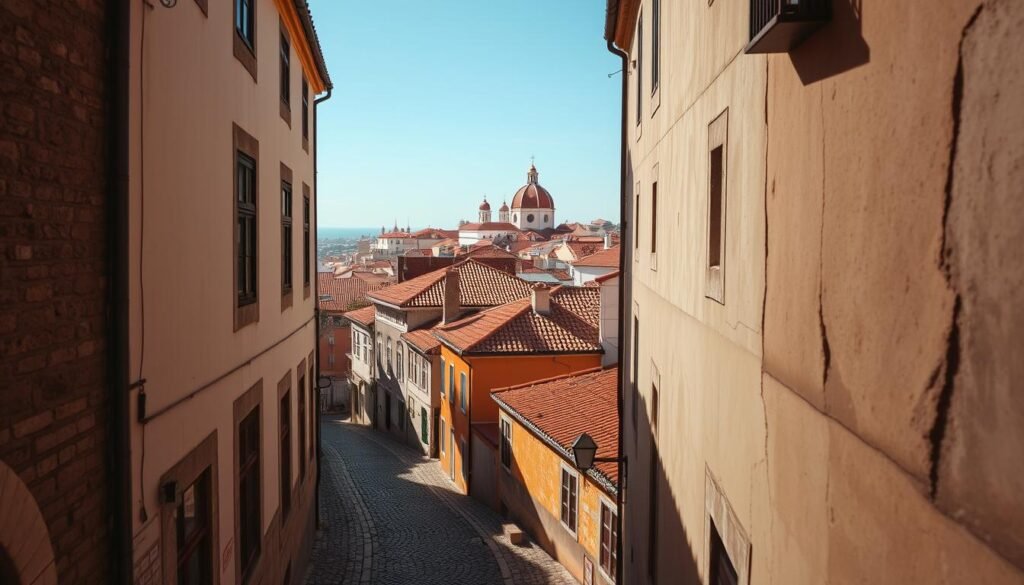
Walking Alfama lets me sidestep long tram lines and linger where the city reveals small, bright moments.best-places-to-visit-in-november/
I note that Tram 28 is iconic, but it draws big crowds and pickpockets. So I trace its highlights by foot. This gives me flexible photo stops and calm pauses.
Miradouro das Portas do Sol & Miradouro de Santa Luzia
I start at Portas do Sol for a wide sweep over terracotta roofs. Then I slip to Santa Luzia for azulejo‑lined terraces and bougainvillea frames.
Cathedral, Pantheon, and São Vicente de Fora
I pop into the Sé Cathedral for cool Gothic calm, then climb toward the National Pantheon for dome-top perspectives.
- I time a Tuesday or Saturday for Feira da Ladra near the Pantheon and São Vicente de Fora.
- I meander narrow streets, letting tiled walls, laundry lines, and tiny taverns guide my photos and quick snacks.
- I chat with locals at kiosks and cafés, which feels more natural when I’m on foot.
“Skip the tram line; walking this route lets you linger at viewpoints and discover quieter corners.”
Route tip: end near São Vicente de Fora for sunset—its terraces catch the warm light across Alfama’s rooftops and make a calm finish to a half‑day exploration.
Funiculars and the Santa Justa Lift: Beating the Hills the Fun Way
![]()
Early mornings on the funiculars give me quiet frames and clean light for classic street shots. I treat these lifts as both transit and small attractions.
Elevador da Bica’s iconic photo op
Elevador da Bica runs roughly 7 am–9 pm on weekdays and from 9 am on weekends. I hop on with my 24‑hour transport pass and save a separate ticket.
I usually take the first car for uncluttered photos down the narrow street.
Glória up to São Pedro de Alcântara
Elevador da Glória runs late, often until midnight, and drops you near Miradouro de São Pedro de Alcântara. I time this ride for sunset and linger for musicians and skyline views.
My shortcut to the Santa Justa terrace
The Santa Justa Lift can have long lines, but I use a simple walking hack. From Rua Garrett, I cut up Calçada do Sacramento and Largo do Carmo and reach the terrace in a few minutes.
If I already have the pass, the Lift is included, so I grab it when the line shortens. This method is a practical way to skip waits and save energy on steep hills.things-to-do-in-prague
“Validate your pass before the first board and keep it handy for quick taps at each entry.”
| Lift | Hours | Best use |
|---|---|---|
| Elevador da Bica | Weekdays 7:00–21:00; weekends from 9:00 | Early photos, quick descent |
| Elevador da Glória | Until ~24:00 | Sunset to São Pedro de Alcântara |
| Santa Justa Lift | Varied — queue peak midday | Terrace views; include with pass or walk shortcut |
Viewpoints and Rooftop Bars for the Best Sunset Views
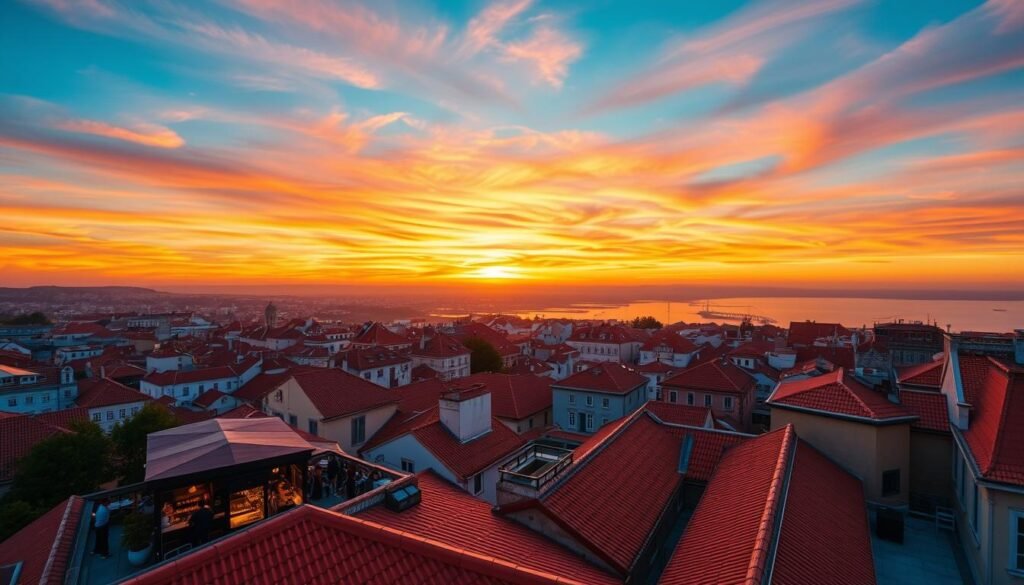
I often chase the last hour of daylight across rooftops, picking spots that frame the river and the castle.
Senhora do Monte gives the widest city arc and feels roomy at dusk. I like Graça for a quieter, neighborhood mood and softer light. Then I slide down toward São Pedro de Alcântara for music, street performers, and twinkling lights over Baixa.things-to-do-in-lake-george
Miradouros I favor
- Senhora do Monte — widest panorama; best for sweeping skyline shots across the river and castle ridge.
- Graça — mellow vibe; I linger for local charm and calm photos.
- São Pedro de Alcântara — lively finish; great for night lights and quick snacks nearby.
Rooftop bars for a sundowner
I rotate three favorites for different moods: PARK for a laid-back garden atmosphere, TOPO for buzzy energy, and Seen Sky Bar for a polished hotel rooftop scene. These spots get very busy at golden hour, so I arrive early for a good table.
- I sip a light white at PARK and favor the river angle; at TOPO I pick a cocktail and face the castle ridge.
- Seen is my choice for sleek photos across the bridge; a scarf is handy as terraces cool quickly.
- Bring light bites or choose nearby restaurants if lines are long—waiting for a table at peak sunset is common.
“Hazy evenings can yield the richest color after the sun drops — watch how the light softens and the city takes on deeper tones.”
For more options and practical tips on rooftop timing, see a short list of the best rooftop and sunset bars.
Oceanfront Modern Lisbon: Lisbon Oceanarium and Parque das Nações
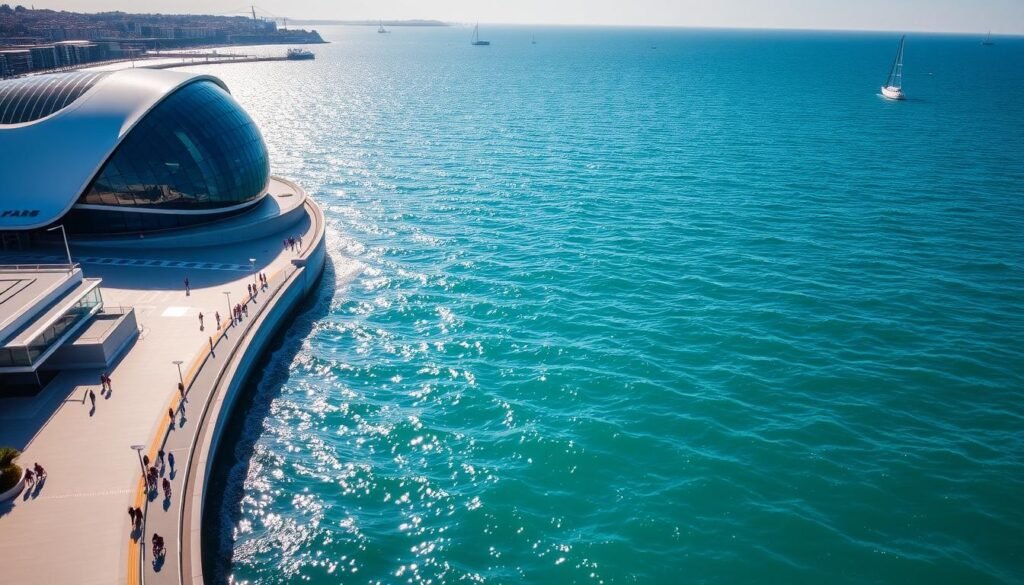
I carve out a half day here when I want a calm, modern contrast with the old center. The area feels like a light, airy part of the city, where architecture and riverfront paths invite slow exploration.
Lisbon Oceanarium is one of Europe’s largest and is built around a massive central tank. The tank sits at the heart of the building and creates an immersive open‑ocean feel as you move between themed habitats: Atlantic, Pacific, Indian, and Antarctic.
Central tank magic, penguin feedings, and the cable car
I linger by the penguin pool for a chance to catch a feeding; signage shows each bird by band color so you can learn their little personalities. After a morning slot at the Oceanarium, I often ride the riverside cable car for aerial views across Parque das Nações.
- Plan: book a morning entry, then glide the cable car for fresh air and skyline angles.
- I leave a few minutes to walk the promenade and grab a snack at waterside cafés.
- Metro access makes this a simple add‑on with several practical options for transit.
The exhibits are well-signed in English, so you can move at your own pace and learn as you go. While the scene is kid‑friendly, I find the Oceanarium equally compelling for adults and photographers who love crisp reflections on the river.things-to-do-in-naples/
“Light off the Tagus here makes for sharp photos and a refreshing change of scene within minutes of the center.”
LX Factory Creativity: Street Art, Eats, and Ler Devagar
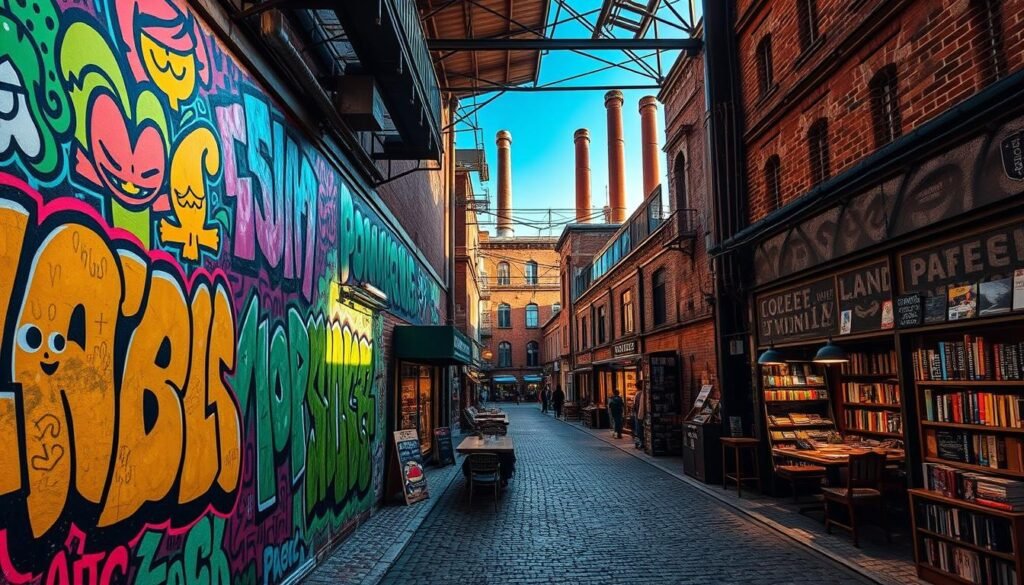
I often hop off a tram and find LX Factory’s lanes humming with creative energy and bold murals.
This converted 19th‑century industrial complex sits under the 25 de Abril Bridge and has become a lively space for makers, cafés, and events.
I wander the narrow courtyards looking for large‑scale murals and hidden studio doors. The street faces are always changing; rotating pop‑ups keep the scene fresh even after repeat visits.
I graze my way through the market stalls and small restaurants, then settle on a patio under the bridge’s red spine.
Ler Devagar is a highlight: multi‑level book stacks, an old press, and a quiet café corner where I sip coffee and read for a while.
- I browse local maker shops for ceramics and prints—real finds that beat typical souvenirs.
- I time visits late morning or mid‑afternoon to avoid meal crowds and have room to explore.
- Bring a small tote; between books and crafts, I always end up shopping a little.
“A compact circuit lets me see a lot in an hour while soaking up the creative mood.”
For Book Lovers: Livraria Bertrand and Other Literary Gems
I often find the quietest pleasures are pages turned slowly in a sunlit shop off a busy square.
Start at Livraria Bertrand on Rua Garrett 73-75. Dating to 1732, it is recognized as the world’s oldest operating bookstore. I browse Portuguese and English titles and ask staff for the special stamp on my purchase. The store’s name carries Lisbon’s reading history while the interior feels modern and warm.
Ler Devagar’s photogenic stacks and coffee break
Ler Devagar offers a multi-level space that blends library, art, record shop, and café. I head there for gallery-like aisles and great photo corners among tall stacks.
- I pair Bertrand with a coffee at A Brasileira for a classic Chiado stop.
- If I missed Ler Devagar earlier, I return and linger with an espresso in a quiet nook.
- I pick slim volumes by Portuguese authors—small, meaningful souvenirs and reading that deepens my walks through the city.
“Stamped books and small press prints make tidy gifts and vivid reminders of a slow afternoon among shelves.”
Art and Architecture Fix: MAAT and the Calouste Gulbenkian
A short museum hop gave me two very different takes on how this city holds art and architecture.
MAAT’s riverfront curves and free rooftop walk
I return to MAAT for its wavy exterior and the free rooftop walk. The museum opened in 2016 and explores art, architecture, and technology in a bold waterfront setting.
Tip: Even if I skip an exhibit, the building itself offers one of the most photogenic modern moments along the Tagus.things-to-do-in-bend-oregon
Gulbenkian’s collection and tranquil gardens
The Calouste Gulbenkian houses about 6,000 pieces from antiquities to Art Nouveau. Inside, galleries feel calm and the museum space is easy to move through.
I usually spend an hour or two wandering the rooms, then decompress in the shaded gardens. The nearby CAM adds a contemporary counterpoint when I have extra time.
| Spot | Focus | Best time |
|---|---|---|
| MAAT | Modern exhibitions, rooftop views | Late afternoon for light |
| Calouste Gulbenkian | Historic collection and gardens | Morning for quiet galleries |
| CAM (Modern Art Center) | Contemporary shows | Check temporary exhibits |
“These two stops bookend a broader cultural arc: forward‑looking design and a deep private collection.”
Traditional Portuguese Flavors I Never Skip
Food frames my best memories here: little plates, bold seafood, and a straight shot of cherry liqueur.
Pastéis de nata began in monastery kitchens and the originals in Belém are still a ritual. I start sweet with a warm tart from a neighborhood bakery when I cannot reach the original shop.
Pastéis, bifanas, and petiscos
I grab a hot bifana near Baixa and Santa Justa — quick, juicy, and loved by locals for lunch. For variety, I order petiscos and share small plates so I can taste more without overdoing it.
Seafood hits: bacalhau, clams Bulhão Pato, and polvo
Dinner usually centers on seafood. I seek bacalhau in its many preparations, Ameijoas à Bulhão Pato to mop up with bread, and Polvo à lagareiro for thick cuts of tender octopus in garlic and olive oil.
Ginjinha sips — bonus points for a chocolate cup
I finish with a quick ginjinha at a historic counter. When offered in a chocolate cup, it feels like a playful treat worth the extra calories.
“Ask servers for their favorite plate — it’s the fastest route to what’s freshest that day.”
| Dish | Where I try it | Why I love it |
|---|---|---|
| Pastéis de nata | Belém or local bakery | Warm, flaky, iconic pastry |
| Bifana | Near Santa Justa / Baixa counters | Fast, savory lunch; beloved by locals |
| Ameijoas à Bulhão Pato | Simple seafood restaurants | Lemony clams for bread‑mopping |
| Polvo à lagareiro | Cozy seafood restaurants | Garlic‑rich, tender octopus |
For a deeper tasting list and recommended spots, see my short guide on traditional Portuguese foods.
Markets and Food Halls: Where I Snack and Shop
Markets are where I judge a city — by how it smells, sounds, and feeds its own people. I spend a day moving between a curated hall and a neighborhood market for variety and pace.
Mercado de Campo de Ourique and Time Out Market
Time Out Market is a curated food hall with chef-run stalls under one roof. It buzzes with famous names but can feel overpriced and crowded at peak hours. I usually visit off-peak for quicker seats.
Mercado de Campo de Ourique blends fresh vendors with ready-to-eat stands and a relaxed local vibe. Here I browse produce, grab small plates, and find easier seating away from the tourist crush.
Feira da Ladra: a flea market treasure hunt
Feira da Ladra runs Tuesdays and Saturdays at Campo de Santa Clara near the National Pantheon. I bring cash for bargaining and keep purchases small enough to fit in my carry-on.
I pair a morning at the market with a Pantheon terrace visit for a satisfying half‑day loop and a few photos of the hillside setting.
| Spot | Vibe | Best for |
|---|---|---|
| Time Out Market | Buzzy, chef-focused | Wide food choices, social scene |
| Mercado de Campo de Ourique | Local, relaxed | Fresh produce, sit-down plates |
| Feira da Ladra | Eclectic, vintage | Antiques, books, ceramics |
My quick tips: plan a snack-through lunch with a couple of small plates. Look for artisan tinned fish, olive oil, and local sweets when you shop for edible souvenirs. Most stalls offer vegetarian and seafood options, so groups have varied choices. Pace your tasting — markets reward a slow, curious appetite.
Fado by Night: Melancholic Music in Historic Spaces
On a cool evening I follow narrow alleys toward small taverns where voices bend and strings answer.
Fado is Portugal’s traditional, melancholic music. I plan one night around Bairro Alto or Alfama, where the songs grew up in tight, smoky rooms.
Bairro Alto and Alfama venues I’d line up for
I queue early for A Tasca do Chico to catch intimate sets for the price of a drink. I accept standing room until a table frees up.
I book a dinner show at Mesa de Frades when I want a more polished experience. If I arrive late, I slip in after the meal service and stay for drinks and shorter sets.
- Sets run short with pauses; time your entry between performances.
- Keep dinner light beforehand or fold it into the show, depending on the venue format.
- Bring cash for small covers or minimums and hush conversation when a set starts.
“The payoff is a night where close‑quarters voice and Portuguese guitar make the room feel like an old story.”
| Venue | Vibe | Best approach |
|---|---|---|
| A Tasca do Chico | Raw, intimate | Queue early; casual drink cover |
| Mesa de Frades | Staged dinner show | Book ahead for dinner; late entry for drinks |
| Small taverns (various) | Local, compact | Arrive early; be patient for seats |
Quick guide for first‑timers: arrive early, be flexible, and let the music set the pace of your evening. For a deeper look at classic venues and history, see my short feature on Lisboa em Fado.
Across the Water: Cacilhas Ferry for Quiet Streets and Dinner
I take the short Cacilhas ferry from Cais do Sodré when I need a breezy escape and a different angle on the river.things-to-do-in-atlantic-city
The crossing offers clean skyline views and leads to calmer streets on the far bank. I always check the terminal—ferries from Praça do Comércio run different routes and may not be covered by some passes.
Views from the cacilheiro and seafood on the far bank
The waterfront at Cacilhas feels relaxed compared with the busy city. Classic seafood restaurants line the quay and outdoor tables face Lisbon’s lights.
I like to wander up the main road for vintage finds at Retro Queen before picking a table. My usual order is grilled sardines, seafood rice, or shrimp while the river and passing boats set the mood.
Practical notes:
- I time the return so dessert is unhurried and the crossing back drops me into the center within minutes.
- Bring a light layer for the cool air off the water after sunset and pick a mid‑week evening if reservations matter.
- This is an easy add‑on when you’re near Time Out Market or Pink Street in the afternoon—an effortless way to slow down without a big schedule shift.
“A calm ferry ride and a seafood dinner on the far bank offer a fresh perspective with minimal time investment.”
| Feature | Why it matters | Tip |
|---|---|---|
| Departure point | Cais do Sodré — quickest link from central transit | Confirm terminal; Praça do Comércio ferries differ |
| Atmosphere | Quieter streets, waterfront dining | Choose outdoor seating if weather allows |
| Local highlight | Retro Queen vintage shop nearby | Just a few minutes’ walk from the terminal |
| Return timing | Fast crossing back to the center | Plan returns in advance—arrives within minutes |
Easy Day Trip Options: Sintra, Cascais, and Cabo da Roca
I carve a full day around Sintra when I want fairy‑tale palaces, coastal cliffs, and easy train links from the city. Morning light and fewer people make the hilltop sites feel personal and photogenic.
Pena Palace first, then Moorish Castle and town strolls
I catch the train from Rossio; they run roughly every 20–30 minutes and the ride takes about 40 minutes. I use that time to map my route and sip coffee.
Start early at Pena Palace to beat lines. Then I walk downhill to the Moorish Castle and wander into the historic town for a pastry and narrow‑street photos.
Buy or reserve a timed ticket for Pena when possible — it smooths entry and saves precious time on a packed day.
Coastal time in Cascais and the cliffs at Boca do Inferno
Cascais is an easy coastal ride from Cais do Sodré. I time an afternoon there, walk the seafront, and watch surf hit Boca do Inferno’s cliffs.
If daylight allows, I add Cabo da Roca for dramatic headlands and the “edge of Europe” feel. I pack layers, snacks, and water so I can move quickly between spots.
- I weigh a guided tour when I want a tighter schedule or a driver linking multiple stops.
- I return in the evening for a slow walk through town and a light dinner to cap a full travel day.
“Start early, reserve tickets where you can, and let the train ride set the pace for a flexible, rewarding day trip.”
Conclusion
I close by saying this folded city gives its best moments when you mix planned anchors with loose wandering. Plan mornings at Belém, the castle, or MAAT, then leave a little free time for tiled lanes, cafés, and river walks.
Use a transport pass as a simple way to conquer hills and link neighborhoods. Weave in a ferry or a funicular ride for fresh angles, and aim for one evening at a miradouro or rooftop to let the skyline settle as lights come on.
Even a short trip rewards a clustered route and early or late visits. For a compact itinerary and practical pacing, see this 3‑day plan: three-day roadmap. I hope the light, music, and flavors leave you as smitten as they left me.








